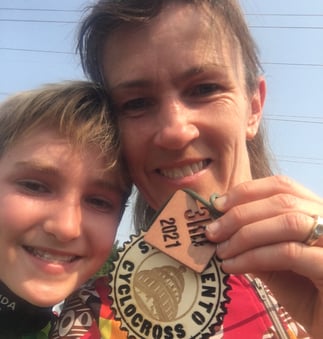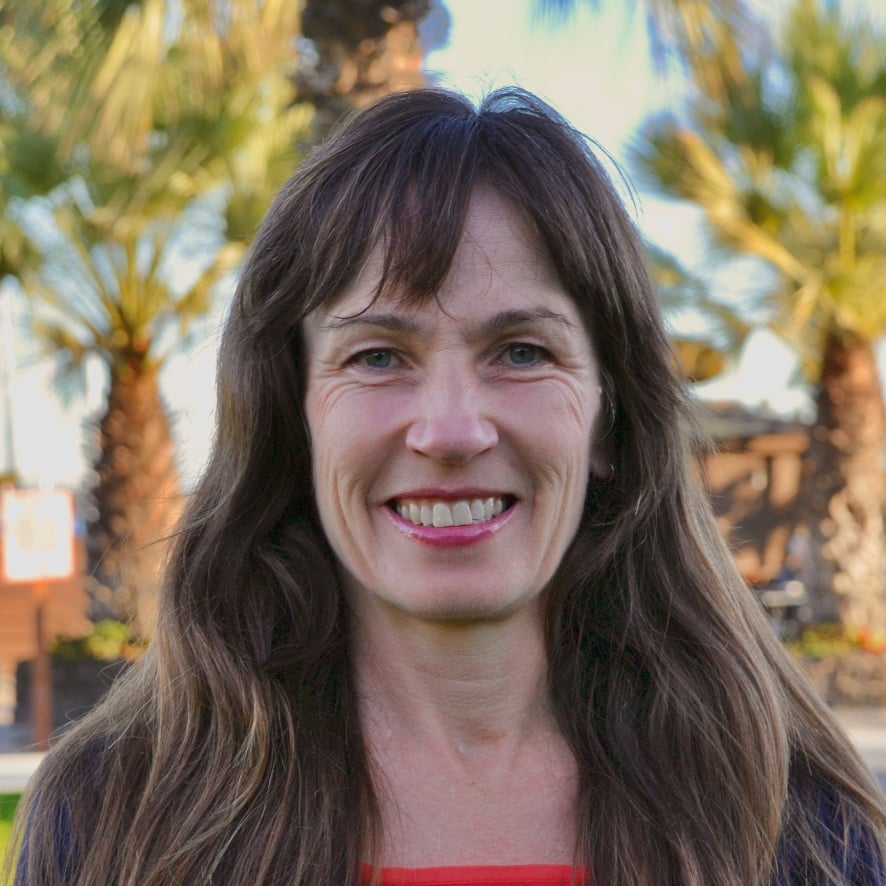LENGTH OF STAY THE PODIUM, PATIENT FLOW THE TRAINING THAT GETS YOU THERE
- Dorothy Whelan
- 02/22/2022
One of our core values at Agathos is curiosity. As our culture page explains, we are lifelong learners and seekers who do creative work and admire that of others. So when my son was encouraged to try cyclocross to stay in shape during the mountain biking off season, I was very curious. After his first race, that curiosity took over and I entered the next race myself. It was so. much. fun. That was seven years ago and the last few years I’ve really invested more heavily in both the sport and the cyclocross community.
So what could cyclocross possibly have to do with length of stay and patient flow? As it turns out, quite a bit. I am going to do my best in this post to use cyclocross to help you see the relationship between these two daunting healthcare challenges. As the title suggests, length of stay is the podium, and patient flow is the training that gets you there.

But first, what is cyclocross?
For context, it may be helpful to understand the basics of cyclocross. According to usacycling.org, “Cyclocross is a unique, non-Olympic discipline of cycling that can best be described as a cross between road cycling, mountain biking and steeplechase.” You can watch some of the highlights from a recent elite women’s cyclocross race here.
It is a race. It demands all types of agility, fitness, and mental acuity. My basic premise is this: Length of stay is like getting to the winners’ podium. That is your desired result. But how do you get there? By developing a healthy, strong, and fast body/mind — I will clumsily abbreviate that as HSFBM for simplicity. (I will also ignore your eye rolls. It is just a metaphor.) Patient flow is the HSFBM that puts you on the length-of-stay podium.
Many moving parts in patient flow, HSFBM
As you can imagine, both patient flow and HSFBM have a lot of moving pieces. In preparing for cyclocross, there are so many things to pay attention to: nutrition, cardio, strength, endurance, technical skills, sleep, mental health, bike mechanics, and knowing the race course. In the hospital, there are countless things you have to work on to achieve good patient flow. It can be overwhelming. This is where Agathos can help. Agathos supports your team in improving common, clearly-defined physician patterns that improve patient flow. Before we race into that, allow me to briefly explain our general approach to improving healthcare delivery.
How Agathos approaches length of stay and patient flow
Agathos begins by targeting unnecessary clinical variation. We show physicians how their practice patterns compare to those of their peers. This piques their curiosity and sparks self-determined change that lowers the cost of care and improves patient outcomes.
Minimal administrative overhead, no nagging — just a text
Agathos sparks that practice pattern change with minimal organizational impact, administrative overhead, or even telling physicians what to do. We send one text per week that physicians can consider whenever convenient. And they change behaviors on their own. We have plenty of information on Agathos throughout this website, so I will move on with how that would work at reducing both length of stay and improving patient flow.
It all comes down to what practice patterns we track and share with physicians. After that, it is in the physicians’ hands to do what they see best. Just like cyclocross racers, physicians are competitive and, always looking to improve, they adjust their practice patterns. (View case studies here.)
Emergency medicine practice patterns to measure
For those of you focusing on the art of emergency medicine, Agathos tracks a number of what we call “insights” related to patient flow. You might see these as similar to a trainer watching you during group circuit training (moving from exercise station to station) to prepare for your cyclocross race — acting like a mirror for you so you can see how your form is as you train.
All of these Agathos insights have a direct relationship with improving patient flow:
- EM door to exit
- EM door to orders
- EM door to disposition
- EM room to doctor
- EM doctor to orders
- EM doctor to disposition

Attribution matters in data related to patient flow
Now, you might have questions about attribution. Attribution matters. A lot. If physicians do not trust your data, they are not going to believe the peer comparison charts that show how they stack up against their peers. If you are familiar with Strava or other online fitness communities that allow you to train and compare how you are doing against your friends, you can imagine how inaccurate data in areas like speed or distance would impact your experience.
When it comes to Agathos, physicians get accurate data, properly attributed, and they trust it. Because of that trust, they also engage with the data. More than 85 percent of physicians with access to our data engage with it every month. Can your existing dashboards do that? Based on my experience, I can almost guarantee your answer is, “No.”
Engaged physicians change behaviors that lead to better patient flow.
Considering data around diagnostics and consults
Now, consider another angle on patient flow: that of diagnostic and consult related insights. Diagnostics and consult practice patterns impact patient flow (as you may already know) because it can take a long time to perform the test/get the consult and get results back. All of this prolongs patients' stay in the ED or hospital. As it relates to cyclocross, we might think of these insights like trying to keep a balanced diet with all the right nutrients to support our health, as well as appropriate sleep and hydration. Too little or too much can both lead to problems.
With that in mind, Agathos tracks the insights below (EM: emergency medicine; HM: hospital medicine):
- EM CT utilization
- EM MRI utilization
- EM urinalysis utilization
- EM magnesium test utilization
- EM phosphorus test utilization
- HM CT utilization
- HM MRI utilization
- HM consult utilization
Measuring where, how, and when you move patients
We also provide a number of insights that target where patients go and when. Consider the LOS impact in these examples:
- appropriately sending patients home instead of admitting them to the hospital or observation can free up beds for patients who are in need
- discharging patients when they are ready to go even if it is a weekend day can free up a bed that is being unnecessarily occupied
In our ongoing cyclocross metaphor, this might be like your knowledge of the course and your strategy to be as efficient as possible in the various transitions during the race. This parallel is particularly relevant as all of these insights have to do with how and when patients are moved:
- EM disposition: discharge to home vs observation
- EM disposition: discharge to home vs inpatient
- HM weekend discharges
- HM handoff efficiency
- HM discharge to home vs SNF
- HM palliative care consults
The dreaded readmission
We all know how important this statistic has been — especially related to governmental fines. These are cases where patients may have been discharged too early, or perhaps without the right care or follow up and then end up coming back. This adds to potentially wasted resources and bottlenecks in the ED and hospital. Our two related insights are pretty clear:
- HM readmissions
- ED bouncebacks
In cyclocross, the parallel might be knowing that you need to shift into a lower gear in anticipation of a big hill coming up, unclip from your pedal in anticipation of an obstacle, or eat an energy gel before you get so hungry that you cannot think straight. If you do not do these things early, you hurt your time because you still have to do them, and under more difficult conditions.
Of course, workflow has a direct impact on patient flow and length of stay
A small handful of workflow-related insights can help make a difference on both patient flow and length of stay. Consider the impact these measures have on your overall operations:
- HM early discharge orders
- HM early PT/OT consults
- HM final medication reconciliation by 11 a.m.
In our metaphor, we might liken this to simply running a smart cyclocross race, getting to the lead spot at the gun, being in front at the first turn of the course, or maybe the first to get over an obstacle. All of these would directly impact your podium chances.
Across our client base, we have seen a positive impact on length of stay when we actively engage physicians in raising their awareness around these practice patterns.
Cheating the system to get to the LOS podium
Of course, you can try to cheat the system. If you cheat on patient flow to achieve good LOS — just like you can cheat on HSFBM (healthy, strong, fast, body, mind) to get the cyclocross podium — it will come back to bite you. If you cheat patient flow and discharge patients too early, for example, you will end up with higher readmissions. Likewise, if you cheat HSFBM and overtrain or take a line on a corner that you cannot handle, you might make the podium but then end up burnt out or injured.
Getting to the LOS podium
Many young athletes have an easy time envisioning themselves standing on the podium and how cool that will look to their friends, family, and maybe to the cyclocross community. Few young athletes are as excited about the day-to-day investment in the habits (the HSFBM) that build lasting change that leads to the podium. It is hard work.
Similarly, it is easy for hospital administrators to focus on a single metric like length of stay, but may not always see that a focus on the more discrete practice patterns can — especially in aggregate — lead to an impressive impact on length of stay. When you get your patient flow together, you are better positioning your healthcare organization to capture a place on the podium of reduced LOS and better health care.
About Author

Dorothy Whelan
Dori has over 20 years of experience in health care informatics and quality improvement. She brings both the health plan and physician organization perspective to improving value and quality of patient care. Prior to joining Agathos in October 2021, Dori was Director of Variation Reduction at Sutter Health.

